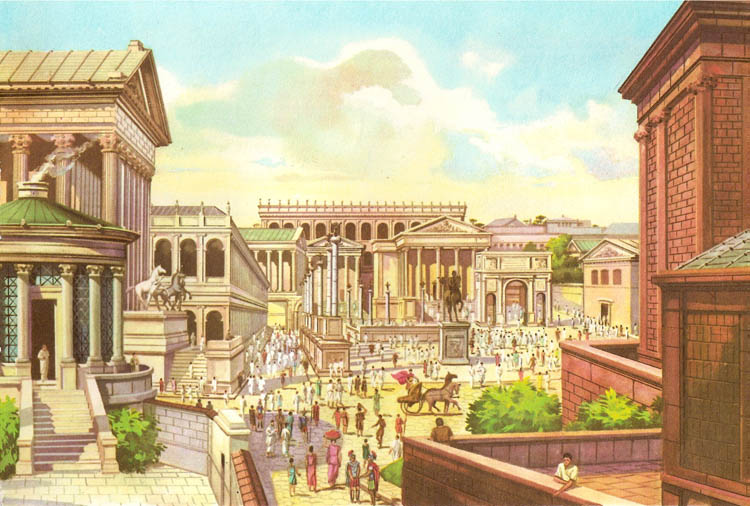Forum Romanum

A reconstruction of the Forum Romanum, as it appeared at the time of the Emperors. In the background is the Temple of Jupiter on the Capitol.
Origins of Rome and the Forum
At the beginning of the 8th century BC, a few shepherds of Latium settled on the Palatine Hill, not far from the left bank of the Tiber. After some time their village was joined to other villages on the neighboring Esquiline and Quirinal Hills, so forming a city-state called Rome.
According to tradition, in the middle of the sixth century BC, Tarquinius Superbus, the last King of Rome, built the Cloaca Maxima, an enormous canal or sewer, to drain the swampy and unhealthy valley between these hills. Previously the edges of the valley had been used as burial grounds; now it was to be the forum, or market-place.
These early settlers could have had no idea that their little city was one day to become part of the most powerful and famous empire throughout the world.
The Forum Romanum
The Romans always considered the original, or "Roman," Forum (also called the Forum Magnum) at the foot of the Palatine Hill as the Forum, although it was by no means the only one in the city. Other and "imperial" Fora were by Julius Caesar and several of the Emperors.
For a long time the Forum was an ordinary market-place, with butchers' and greengrocers' shops beside the temples. But by the third century BC the Romans felt that their city-center should be more dignified. They therefore replaced the small shops by "basilicas"; these were large buildings used as the law courts and also for large-scale business, as in a modern stock-exchange.
The Forum was the heart of Rome and indeed of the whole Roman Empire. All kinds of people met there. Some might have business in one of the basilicas, or a sacrifice to attend at one of the many temples. Others simply walked about, satisfying their curiosity or discussing the latest political news with friends.
The central space was the meeting-place of the plebians, Comitia Tributa; while the patricians, Comitia Centuriata, met on the Comitium, adjoining the Forum.
The illustration above shows a reconstruction of the Forum. On the left are the circular Temple of Vesta, the Temple of Castor and Pollux, and the Basilica Julia; on the right, to the right of the Arch of Septimius Severus, is the Senate House and part of the Sacred Way, along which triumphal processions made their way to the Capitol.
